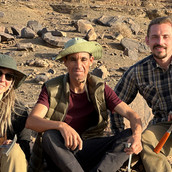Ural Federal University Scientist Retrieves Dinosaur and Animal Remains from Sahara Excavations
Anton Kochnev, a junior researcher at the Laboratory of Natural Science Methods in Humanities at UrFU, and his colleagues from Moscow State University (MSU) and Moulay Ismail University (Meknes, Morocco) visited excavations in the Sahara Desert (Morocco). The scientists managed to discover the remains of dinosaurs, invertebrates, and other animals, which they brought to Russia.
“It was a joint expedition with colleagues from MSU. We were invited as foreign participants. Foreign specialists from all over the world often visit the Kingdom of Morocco. These days, many articles have been published in scientific journals describing finds from the Sahara and Morocco in particular,” says Anton Kochnev.
As paleontologists explain, the Sahara is rich in fossils from a wide variety of periods: the Paleozoic (from 500 million years to 300 million years ago), the Mesozoic (from 250 million years to 66 million years ago), and the Cenozoic (began 66 million years ago and continues up to this day) eras. There were seas in the Paleozoic era in the places visited by Russian scientists (Devonian deposits of the Hamar Laghdad Ridge, outcrops to the west of Merzouga, trilobite quarries of the Jebel Issimour Mountains, etc.). There were full-flowing freshwater rivers in the famous Upper Cretaceous Kem Kem Group. These were the places where dinosaurs, including Sauropods and Carcharodontosaurids, flying Pterosaurs, ancient fish, turtles, and crocodiles swam.
“We visited several Paleozoic sections: Ordovician, Silurian, Devonian, and Carboniferous periods, where we found many interesting fossils. In particular, I was interested in the Fezouata Formation, where we found the remains of Graptolites, extinct marine invertebrates. Some of the finds will be added to the educational collection of the Department of Biological Evolution of Moscow State University, with which students will work within the framework of paleontological disciplines. And it may be possible to use some of the finds, after a detailed study, in scientific articles, or pass them on to colleagues for further study,” explains Yana Shurupova, junior researcher at the Department of Biological Evolution of the MSU Faculty of Biology.
Dinosaur teeth and reptile bones have arrived in Ekaterinburg. Some of the finds will also be transferred to the Department of Zoology at UrFU for educational purposes. For example, a fragment of the skeleton of a Dunkleosteus (shellfish, the largest marine predator that lived 435-360 million years ago). As Anton Kochnev explains, the scientists’ goal is not only to find and describe new species of animals but also to replenish visual material for biology students and to pass the specimens to other narrowly specialized scientists (including those in St. Petersburg) who are engaged in research on these periods and areas.
“Of scientific interest to me was the Kem-Kem Group, which is a location at the end of the Mesozoic Era, about 90 million years ago, where we managed to find a whole Spinosaur tooth, fragments of Pterosaur bones and teeth, crocodile and Carcharodontosaurus teeth, fragments of Onchopristis rostrum of a saw-winged stingray, and many other amazing finds. But these are all described species, so the most interesting find was three small vertebrae of reptiles. My colleagues and I have yet to study their morphology and determine who they belonged to: baby dinosaurs or reptiles (snakes or baby crocodiles), they all lived with the dinosaurs at the time. This is interesting because there is always the possibility of finding and describing a new species. In addition, the finds will help expand the understanding of the faunas of the Cretaceous period and evolution in general,” Anton Kochnev lists.
The scientist adds that it is challenging to find large bones in such places (rock ledges in the desert that were once part of the sea but have come to the surface in a result of tectonic shifts). This requires luck and full-scale excavations with an impressive expedition team. Scientists from Russia had only 11 days for the expedition.

